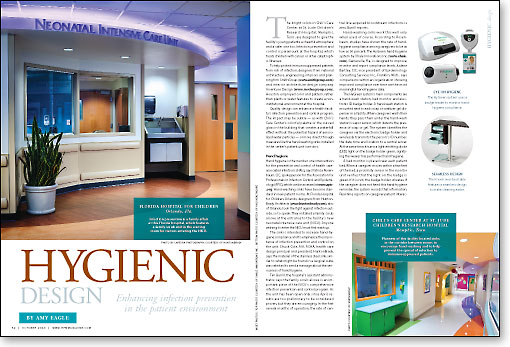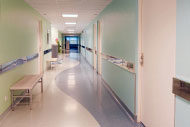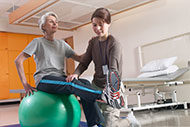Download Hygienic Design Section(PDF)
The bright colors in Chili's Care Center at St. Jude Children's Research Hospital, Memphis, Tenn., are designed to give the facility's young patients a cheerful atmosphere and a safer one too. Infection prevention and control is paramount at the hospital, which treats children with cancer or other catastrophic illnesses.
To help protect immunosuppressed patients from risk of infection, designers from national architecture, engineering, interiors and planning firm SmithGroup (www.smithgroup.com) and interior architecture design company Inventure Design (www.invdesgroup.com), Houston, employed color and pattern, rather than plants or water features, to create a non-institutional environment at the hospital.
Quality design can enhance a health facility's infection prevention and control program. The impact may be subtle — as with Chili's Care Center's colorful palette or the curved glass in the building that creates a waterfall effect without the potential hazard of aerosolized water particles — or more direct, through measures like the hand-washing sinks installed in the center's patient unit corridors.
Hand hygiene
Hand hygiene is the number one intervention for the prevention and control of health care-associated infections (HAIs), says Patricia Rosenbaum, CIC, spokesperson for the Association for Professionals in Infection Control and Epidemiology (APIC), which can be accessed at www.apic.org. Hand-washing sinks have become standard in new patient rooms. At Florida Hospital for Children, Orlando, designers from HuntonBrady Architects (www.huntonbrady.com), also of Orlando, took the fight against infection outside, so to speak. They installed a family scrub alcove at the entrance to the facility's new neonatal intensive care unit (NICU). Anyone wishing to enter the NICU must first wash up.
The sink is intended to increase hand-hygiene compliance and to emphasize the importance of infection prevention and control on the unit. Chuck Cole, AIA, ACHA, health care design principal and president, HuntonBrady, says the material of the stainless steel sink, similar to what might be found in a surgical suite, was selected to send a message about the seriousness of hand hygiene.
Tim Burrill, the hospital's assistant administrator, says the family scrub alcove is an important piece of the NICU's comprehensive infection prevention and control program. As the unit has been open only since April, results are too preliminary to be considered proven, but they are encouraging. In the first several months of operation, the rate of central line-acquired bloodstream infections is zero, Burrill reports.
Hand-washing sinks work this well only when used, of course. According to Rosenbaum, studies have shown the rate of hand-hygiene compliance among caregivers to be as low as 50 percent. The HyGreen hand-hygiene system by Xhale Innovations Inc. (www.xhale.com), Gainesville, Fla., is designed to improve, monitor and report compliance levels. Judene Bartley, CIC, vice president of Epidemiology Consulting Services Inc., Franklin, Mich., says comparisons within an organization showing improved compliance over time are the most meaningful hand-hygiene data.
The HyGreen system's main components are a hand-wash station, bed monitor and electronic ID badge holder. A hand-wash station is mounted next to each soap or sanitizer gel dispenser in a facility. When caregivers wash their hands, they pass them under the hand-wash station's vapor sensor, which detects the presence of soap or gel. The system identifies the caregiver via the electronic badge holder and wirelessly transmits the person's ID number, the date, time and location to a central server. At the same time, it turns a light-emitting diode (LED) light on the badge holder green, signifying the wearer has performed hand hygiene.
A bed monitor is placed near each patient bed. When a caregiver moves within a few feet of the bed, a proximity sensor in the monitor unit verifies that the light on the badge is green. If it is not, the badge holder vibrates. If the caregiver does not heed this hand-hygiene reminder, the system records that information. Real-time reports on caregiver-patient interactions can demonstrate compliance to accrediting agencies, identify training issues and help track outbreaks.
Protective design
The location of personal protection equipment like hand-sanitizer dispensers, gowns and gloves can create operational challenges in health care interiors. At Methodist Dallas Medical Center in Texas, designers from international architecture firm HKS Inc. (www.hksinc.com) designed centralized recessed storage areas for these items at the entry to every patient room for easy access by caregivers.
The healthFIRST infection prevention centers by Peter Pepper Products (www.peterpepper.com), Compton, Calif., organize these supplies in freestanding, wall-mounted or mobile cart configurations suitable for patient rooms, exam rooms or public spaces. Each model includes dispensers for a combination of tissues, sanitizer, gloves, gowns or masks. The units are also available with trash receptacles, magazine and brochure racks and space for health information posters.
The Compass system from Herman Miller Inc. (www.hermanmiller.com), Zeeland, Mich., includes storage for protective equipment as one of its many infection prevention and control-minded features. At this year's NeoCon World's Trade Fair design exhibition in Chicago, Compass won the Best of NeoCon Gold Award for health care furnishings.
The Compass sink has rounded corners where bacteria are less likely to adhere and a sloped top surface and narrow edge that discourage people from placing items near the hand-washing area (a cross-contamination risk). To reduce splash back, the faucet is angled backward eight degrees and the drain is offset.
The modular system's tiles and components are fully wrapped, with no edge banding, for a seamless, cleanable, durable surface. The ship-lap, or shingled, design of the Compass tiles and components will not allow spills to seep into the spaces between them. All the pieces sit 20 or more inches off the floor to make them easy to clean beneath.
The Knook over-bed table from Knú Healthcare (www.getknu.com), another Zeeland furniture manufacturer, also features a seamless design. The product's surfaces and storage areas are fabricated of Kydex, a durable thermoformable plastic alloy. The base plate is made of heat-treated, powder-coated aluminum. These materials are strong, smooth and cleanable. The units' drawers are removable to facilitate cleaning and even the Knook's screws have larger heads for easier cleaning.
Architex International (www.architexljh.com), Northbrook, Ill., has introduced a bleach-cleanable upholstery called Remedé, which the firm developed in conjunction with designers from HDR Architecture (www.hdrarchitecture.com), Omaha, Neb. The solution-dyed nylon textile is available with a Nano-Tex moisture barrier and stain-repellent finish. It can withstand the most powerful cleaners used to reduce contamination.






